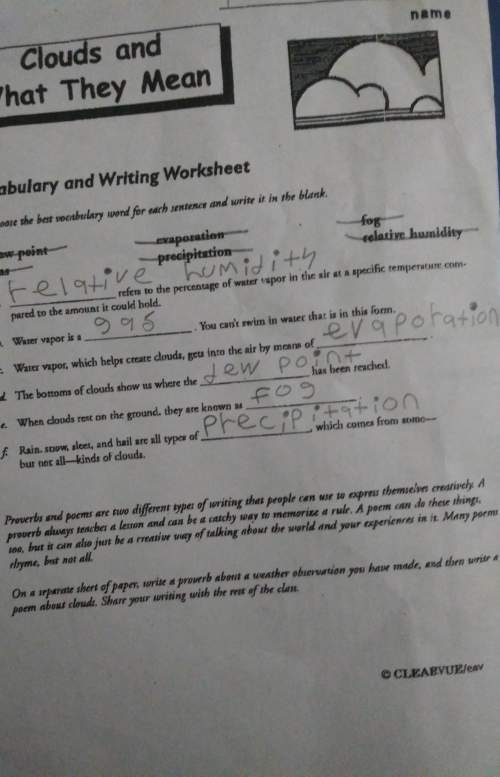Which option describes the direction of thermal energy transfer in Earth's
oceans?
A. From th...


Answers: 3


Other questions on the subject: Physics

Physics, 21.06.2019 17:30, emily9656
Awheel rotates without friction about a stationary horizontal axis at the center of the wheel. a constant tangential force equal to 82.0 n is applied to the rim of the wheel. the wheel has radius 0.150 m . starting from rest, the wheel has an angular speed of 12.8 rev/s after 3.88 s. what is the moment of inertia of the wheel?
Answers: 3

Physics, 22.06.2019 02:40, esheagustafson
What happens when chlorine reacts with bromine? a. electrons move from the chlorine atoms to the bromine atoms. b. electrons move from the bromine atoms to the chlorine atoms. c. electrons are shared between the chlorine atoms and the bromine atoms. d. electrons become delocalized among the atoms.
Answers: 2

Physics, 23.06.2019 02:00, stella013108
Answer asap 50 points which of the following illustrates how a venus fly trap senses that an insect has landed in its open leaves? 1. using tiny hairs, the leaves sense a change in light. 2. using tiny hairs, the leaves taste a chemical. 3. using tiny hairs, the leaves detect a touch. 4. using tiny hairs, the leaves sense a change in water levels.
Answers: 1

Physics, 23.06.2019 10:30, Chapo3760
Up of elements with the same number of valence electrons. vertical column in the periodic table of elements such as alkali metals or halogens. a horizontal row of elements in the periodic table. this is a characteristic of the elements in the periodic table that shows a pattern. it may increase or decrease across or down the table. periodic trend these are the highly reactive elements located in group 1 of the periodic table. these elements have one electron in their outer energy level which makes them highly reactive with water and halogens. these are the reactive elements located in group 2 of the periodic table. these elements have two electrons in their outer energy level which makes them reactive with water and halogens. alkaline earth metals these are the group 3 or d-block elements. these dense metals with high boiling points can have different oxidation states and all are solid at room temperature with the exception of mercury. transition metals this is the highly reactive family of elements with 7 valence electrons. this is an element with full valence shell, very unreactive. this is a group of elements with few valence electrons that conducts heat and electricity. one of a class of elements having properties intermediate to metals and nonmetals. this is a type of element that has many valence electrons, not a conductor.
Answers: 1
You know the right answer?
Questions in other subjects:




Mathematics, 11.02.2020 04:24






Mathematics, 11.02.2020 04:24




